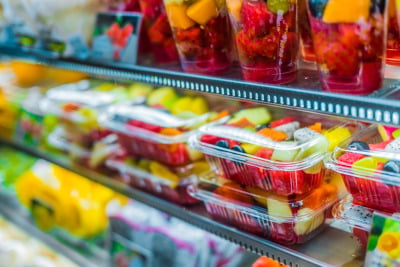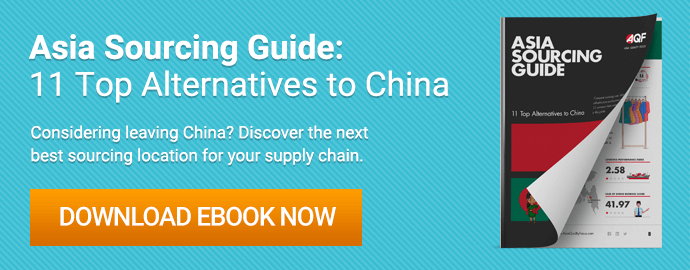Best in Manufacturing – April 27, 2021
Each Tuesday, we publish a list of top articles and other content related to manufacturing in areas like quality control, product development, supply chain management, sourcing, auditing, and law.
1. Mobile Apps: Unexpected Keys to Open Ecommerce Businesses
 Ecommerce is a lifesaver for many businesses amid the pandemic. Many of them have onboarded some famous e-commerce platforms to expand the business and some are building their own websites. But do you know that mobile apps are unexpected keys to eCommerce businesses as well?
Ecommerce is a lifesaver for many businesses amid the pandemic. Many of them have onboarded some famous e-commerce platforms to expand the business and some are building their own websites. But do you know that mobile apps are unexpected keys to eCommerce businesses as well?
An interesting fact is: there are more mobile app users than mobile-optimized website users. Apps are easier to use with seamless navigation and the interface usually looks better. Apps can load quickly and some can also be available offline.
According to a survey by PR Newswire, 80 percent of people now frequently use shopping apps. And, retailers saw a 36 percent increase in mobile app downloads and a 54 percent growth of in-app purchases.
The Wise Marketer summarized three major benefits of using mobile apps:
- Offering a new market channel. Mobile apps won’t be affected by weather or the coronavirus. As long as people have their smartphones, they can “hang around” and “pick” the products they want. This is a non-close store for businesses.
- Customizing shopping experience. On personal mobile phones, the apps can customize the recommendations based on users’ location, search history, gender, etc.
- Improving shopping experience. In the e-store, users can easily find the product they want by searching. They can quickly navigate to checkout and finish the whole purchase with just a few clicks.
Mobile apps are so important to Chinese eCommerce
Among the global eCommerce market, China is the largest ecommerce marketplace by country with annual online sales of $672 billion. Moreover, eCommerce will become China’s main channel of retail in 2021.
China’s success here is greatly supported by mobile apps. According to China Internet Watch, as of 2018, more than 80 percent of Chinese online sales were generated from mobile apps and the number is increasing.
If you are planning to sell your products in China, here are some top Chinese eCommerce mobiles apps that can be your references:
- Taobao: the well-known eCommerce platform operated by Alibaba group, the offshoot of it is Tmall.
- Pinduoduo: a strong leader in group buying, social commerce for bargain hunters.
- Xiaohongshu: an emerging eCommerce marketplace based on social media.
- com: focus on the direct sale of electronic products at first and is now offering a wide range of product types with its top-notch logistics.
- WeChat: the most popular communication app in China. With a huge user base, WeChat is now launching WeChat stores and mini-programs for selling products. Even JD.com and Xiaohongshu have their mini-programs on WeChat.
Don’t relax on the quality control of eCommerce products
Quality control for eCommerce products is as important as for products on shelves as well. It can be even more important as the consumers have not seen or touched the product in person before buying and they might have more expectations for the product that they purchased.
If you are the brands that are planning to join eCommerce sales, here we recommend some best practices for your eCommerce quality control:
- Audit the factory before making the decision. Before deciding on a supplier, a factory audit can help to identify any potential problems and manage your expectations by checking the factory’s environment, certificates, working standards, etc. on site.
- Start only with an approved sample. Approved sample, or the so-called golden sample, is a reference to your standards and requirements. It helps to ensure the consistency of the products that the supplier made.
- Conduct inspections during the manufacturing. In an inspection, the inspector will check the status of the finished goods and perform on-site tests to identify any quality defects at an early stage.
Follow the link below to learn more about how mobile apps are supporting the growth of eCommerce.
How Mobile Apps Are Revolutionizing Ecommerce – Wise Marketer Staff, The Wise Marketer
2. Retailers to give second life to plastic materials
Nowadays, plastics are everywhere in our  daily life. The phone case, the buttons, the shoelace, the milkshake cup…It’s hard to name a product that does not use plastic at all. Plastic bags are so frequently used in retail stores and it has been a problem for retailers to reduce their use of plastics.
daily life. The phone case, the buttons, the shoelace, the milkshake cup…It’s hard to name a product that does not use plastic at all. Plastic bags are so frequently used in retail stores and it has been a problem for retailers to reduce their use of plastics.
And recently, retail chain Smith’s Food&Drug is partnering with its customers to recycle plastics and protect the earth. Smith’s move is a preparation for Earth Day on April 22 and the retailer is encouraging its customers to return thin-filter plastic materials to their local stores – those plastics will be recycled into park benches for the local community.
The plastic materials that customers can return includes:
- Bubble wrap
- Plastic overwrap around paper towels
- Cereal box liners
- Bread bags
- Dry cleaning bags
- Produce bags
- Newspaper sleeves
- Plastic shipping envelopes
- Clean sandwich bags
Aubriana Martindale, Smith’s Corporate Affairs Manager explained the importance in a press release:
Instead of plastic bags ending up in landfills or littering green spaces, we utilize innovative services to turn the material into plastic lumber for the construction of community benches and other items.
In 2020, Smith’s has already recycled 39 million pounds of plastic from its stores. Eying the future, the retailer has committed to phasing out single-use plastic bags from its stores by 2025.
Retail chains globally are reducing their reliance on plastic packaging
Along the whole supply chain, there are different methods to reduce the reliance on plastic material. For example, manufacturers can source replacements for plastics, and apply high-tech methods to accurately control the use of plastic to reduce waste.
And for end chains like retail stores, cutting down plastic packaging might be the most effective way. Plastic packaging is usually deployed to protect the food and preserve freshness. But in the meantime, it also ???
As one of the leaders in the industry, UK retailer Tesco is now updating the plastic packaging in its stores gradually. Tesco’s initiative starts with its own label hard cheese. And the first step is simple: replace the traditional square packaging with the rectangular packaging and remove the re-sealable zip.
The changes seem small, but they can effectively eliminate the use of plastic by 260 tons a year. Almost 40 lines of Tesco hard cheese will apply the new packaging design. Peter Wood, Tesco cheese buying manager, said:
By changing the pack shape and also removing the re-sealable zip we will be able to reduce plastic packaging on our brand hard cheese by up to 40 percent against the former product, depending on the size of the block.
Plastic straws are now being replaced
Aside from those plastic bags and plastic wrappings, plastic straws are also a huge pollution source that you might not be aware of.
Solely in the U.S., people use 500 million drinking straws each day and the majority of those straws are made from plastic. Plastic straws are hard to be biodegraded and can last on the earth for centuries. Worst, dumped into the oceans, those plastic straws can be lethal to marine life such as sea turtles and seagulls.
Thus, many brands or regions are starting to issue bans on plastic straws to reduce the use. Beverage chains and fast-food chains are taking the lead in this campaign.
Let’s take Starbucks for example. Early in 2018, Starbucks announced to phase out plastic straws in its stores. The coffee giant is using strawless lids or material straw options as replacements. As for now, Starbucks has officially abandoned straws in favor of sippy cup lids.
Nonetheless, super-size fast-food chain McDonald’s announced that all its stores in China will start to cast away plastic straws. According to McDonald’s, this move can effectively reduce 400 tons of plastic use a year.
Wishing to know more about the plastic recycling programs? Follow the link below to learn more about Smith’s move on plastic recycles.
Smith's associates remove 140,000 plastic bags from the environment – Jennifer Weaver, KJZZ
3. Gap is updating its supply chain based on customer loyalty
 There is no doubt that the pandemic has accelerated the supply chain update. Disruptions on some random parts of the supply chain can result in a serious delay to the end consumer part and harm brand reputation. How to best allocate the resources and ensure the supply to the most valuable clients is a new question.
There is no doubt that the pandemic has accelerated the supply chain update. Disruptions on some random parts of the supply chain can result in a serious delay to the end consumer part and harm brand reputation. How to best allocate the resources and ensure the supply to the most valuable clients is a new question.
To solve this problem, Gap Inc. recently designed a “smart” fulfillment system to prioritize its top customers.
According to Gap’s latest earning call, the new fulfillment system will classify the clients and tier the delivery speeds as gold, silver, and bronze. Simply speaking, the top clients will get the fastest delivery speeds and vice versa.
For most businesses, there is a classification for clients and usually, the VIP clients are vital to survival. By applying this new system, Gap will be able to better manage the relations with the most important clients and guard a long-term development.
Online business is of great importance to Gap Inc.
Since more people are shifting to shopping online, the online business is taking up an increasing proportion for Gap. In 2020, Gap’s online sales experienced a 54% YoY growth compared to 2019 and reached $6 billion.
Gap attributes the success of its online platform to its "powerful omnichannel platform". Gap Inc.’s CEO Sonia Syngal commented:
We now have over 50% of traffic and 75% of sales annually through mobile. With mobile as the primary engagement platform, we're working quickly to create frictionless mobile shopping and new digital experiences as devices, networks, and customer preferences evolve.
According to Gap’s plan, the garment retailer will replenish during the first half of 2021. But due to recent port delays and surging transit fees, the inventory levels might fall. And if there’s a significant drop in the inventory, such a fulfillment system can ensure presenting the best service to top-ranking clients and remain customer loyal.
Toyota optimized its supply chain to avoid chip shortage mess
For all the companies, a mistake on any part of the supply chain can affect the whole manufacturing and products. For instance, in March 2011, a tsunami struck Japan’s northeastern coastline and knocked some major car chip manufacturing factories offline. These have further caused a supply squeeze and seriously affected automobile giant Toyota Motor Corp.
It took Toyota almost six months to recover from the shortage and the company carefully studied its supply chain to prevent similar crises in the future. Toyota listed out around 1,500 components to ensure the company can have alternatives or stockpiles.
Further, Toyota built a system to monitor its vast supply chain. The system can identify larger or smaller suppliers, track moves within the supply chain, and warn the company in advance of the potential shortage.
Toyota’s update to its supply chain is successful. The move was especially helpful amid the pandemic since the global supply chain was disrupted. Akio Toyoda, Toyota President, addressed the importance of optimizing the supply chain:
…there are automakers that are really struggling and others that are not scarred as deeply. What’s proven important: very close communication between automakers, chipmakers, and the part suppliers that rely on those chips.
In conclusion, in this era of globalization, all businesses are tied to a vast supply chain no matter which industries they are in. Optimize the supply chain based on your needs and try to spot any potential disruption in advance will be a smart choice.
Follow the link below to learn more about how Gap is “customizing” its supply chain.
Gap designs fulfillment system to prioritize 'most valuable' customers – A.B. Brown, Supply Chain Dive
We’re constantly scanning the web for top manufacturing stories and news. If you’d like to submit an article for consideration for our weekly Best in Manufacturing, send us a message and let us know







